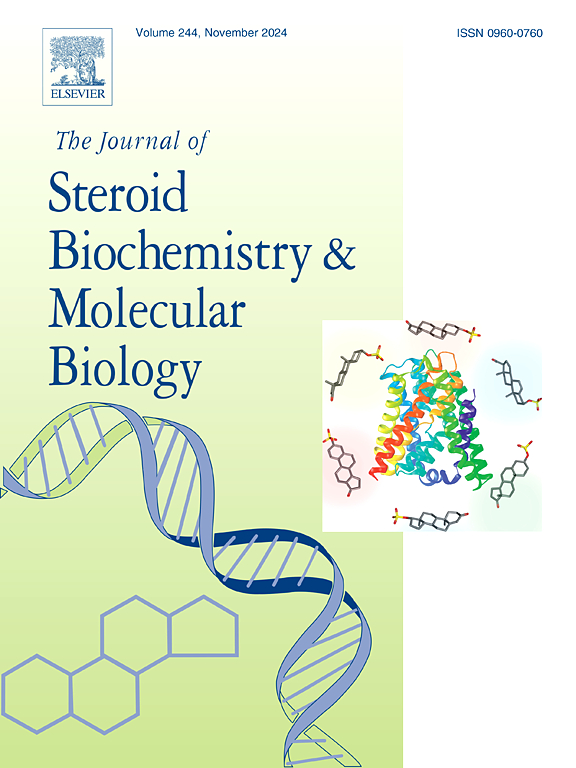解开PCOS的隐藏因素:从转录组学到使用WGCNA, LASSO和ROC分析的关键生物标志物
IF 2.5
2区 生物学
Q3 BIOCHEMISTRY & MOLECULAR BIOLOGY
Journal of Steroid Biochemistry and Molecular Biology
Pub Date : 2025-06-04
DOI:10.1016/j.jsbmb.2025.106795
引用次数: 0
摘要
多囊卵巢综合征(PCOS)是一种以激素失衡、炎症和胰岛素抵抗为特征的复杂内分泌代谢疾病。本研究利用全面的RNA-Seq工作流程来揭示多囊卵巢综合征的分子机制。数据从NCBI- Sequence Read Archive [SRA]存储库中检索,随后使用FastQC和Trimmomatic修剪进行质量评估。使用HISAT2将Reads与GRCh38基因组进行比对,并在R中使用DESeq2进行差异表达分析,鉴定出395个显著的DEGs(268个上调,127个下调)。基因本体(GO)分析揭示了包括蛋白激酶活性激活、端粒酶封顶、蛋白丝氨酸/苏氨酸激酶活性和MAP激酶活性在内的生物过程失调,而KEGG途径分析强调了MAPK信号通路、Ras信号通路和GnRH信号通路等关键信号通路。加权基因共表达网络分析(WGCNA)鉴定了与PCOS性状相关的模块,蛋白质-蛋白质相互作用(PPI)网络分析鉴定了20个枢纽基因。通过最小绝对收缩和选择算子(LASSO)回归分析,确定了PRKACA、SREBF2、MAPT、EHMT1和JUP 5个关键预测基因,突出了它们在PCOS发病机制中的关键作用。通过受试者工作特征(ROC)曲线分析进一步验证了这些基因的预后价值,曲线下面积(AUC)高达0.89。多囊卵巢综合征和健康人群之间的这种强烈的区分力突出了这些生物标志物作为诊断和了解该疾病的可靠指标的潜力。结果突出了这些生物标志物的治疗和诊断潜力,并为PCOS治疗的精准医学方法铺平了道路。本文章由计算机程序翻译,如有差异,请以英文原文为准。
Untangling hidden players of PCOS: From transcriptomics to key biomarkers using WGCNA, LASSO and ROC analysis
Polycystic ovary syndrome (PCOS) is a complex endocrine and metabolic disorder characterized by hormonal imbalance, inflammation and insulin resistance. This study utilized a comprehensive RNA-Seq workflow to uncover the molecular mechanisms underlying PCOS. Data were retrieved from the NCBI- Sequence Read Archive [SRA] repository, followed by quality assessment using FastQC and Trimmomatic trimming. Reads were aligned to the GRCh38 genome using HISAT2 and differential expression analysis was performed by DESeq2 in R, identifying 395 significant DEGs (268 upregulated, 127 downregulated). Gene ontology (GO) analysis revealed dysregulated biological processes including activation of protein kinase activity, telomerase capping, protein serine/ threonine kinase activity and MAP kinase kinase activity, while KEGG pathway analysis highlighted key signaling pathways such as MAPK signaling, Ras signaling, and GnRH signaling. Weighted gene co-expression network analysis (WGCNA) identified modules associated with PCOS traits and Protein-Protein Interaction (PPI) network analysis identified 20 hub genes. Through Least Absolute Shrinkage and Selection Operator (LASSO) regression analysis, five key predictor genes – PRKACA, SREBF2, MAPT, EHMT1, and JUP were identified, highlighting their critical roles in the pathogenesis of PCOS. The prognostic value of these genes was further validated by receiver operating characteristics (ROC) curve analysis, which showed a high area under the curve (AUC) of 0.89. This strong discriminatory power between PCOS and healthy groups highlights the potential of these biomarkers as reliable indicators for diagnosing and understanding the disease. The results highlight the therapeutic and diagnostic potential of these biomarkers and pave the way for precision medicine approaches in PCOS treatment.
求助全文
通过发布文献求助,成功后即可免费获取论文全文。
去求助
来源期刊
CiteScore
8.60
自引率
2.40%
发文量
113
审稿时长
46 days
期刊介绍:
The Journal of Steroid Biochemistry and Molecular Biology is devoted to new experimental and theoretical developments in areas related to steroids including vitamin D, lipids and their metabolomics. The Journal publishes a variety of contributions, including original articles, general and focused reviews, and rapid communications (brief articles of particular interest and clear novelty). Selected cutting-edge topics will be addressed in Special Issues managed by Guest Editors. Special Issues will contain both commissioned reviews and original research papers to provide comprehensive coverage of specific topics, and all submissions will undergo rigorous peer-review prior to publication.

 求助内容:
求助内容: 应助结果提醒方式:
应助结果提醒方式:


